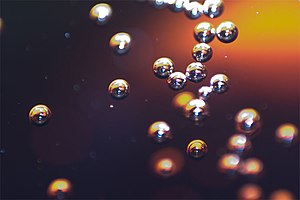Carbonated drink: Difference between revisions
Warning: An automated filter has detected a repeated sequence of characters in this edit. This is often an indicator of vandalism. If the edit is constructive, please go to the bottom of this page and press 'Publish changes' to continue. Otherwise, if your edit is clearly vandalism, you may be blocked from editing Wikipedia. If you are unsure of where the repeated sequence of characters occurs, and this message is in error, please report this. Tags: categories removed references removed Possible vandalism |
m Reverted edits by 203.251.109.253 (talk) (HG) (3.4.4) |
||
| Line 1: | Line 1: | ||
[[Image:Soda bubbles macro.jpg|right|thumb|300px|Bubbles of carbon dioxide float to the surface of a [[Carbonated water|carbonated]] [[soft drink]].]] |
|||
Warning: An automated filter has detected a repeated sequence of characters in this edit. This is often an indicator of vandalism. If the edit is constructive, please go to the bottom of this page and press 'Publish changes' to continue. Otherwise, if your edit is clearly vandalism, you may be blocked from editing Wikipedia. If you are unsure of where the repeated sequence of characters occurs, and this message is in error, please report this. |
|||
'''Carbonated drinks''' are beverages that contain dissolved [[carbon dioxide]]. The [[dissolution (chemistry)|dissolution]] of CO<sub>2</sub> in a [[liquid]], gives rise to ''fizz'' or ''effervescence''. The process usually involves carbon dioxide under high pressure. When the pressure is removed, the carbon dioxide is released from the solution as small bubbles, which causes the solution to become [[Effervescence|effervescent]], or fizzy. A common example is the dissolving of carbon dioxide in [[water]], resulting in [[carbonated water]]. Carbon dioxide is only weakly soluble in water, therefore it separates into a [[gas]] when the pressure is released. |
|||
Carbonated beverages are prepared by mixing flavored syrup with carbonated water, both chilled. Carbonation levels range up to 5 volumes of CO<sub>2</sub> per liquid volume. Ginger ale, colas, and related drinks are carbonated with 3.5 volumes. Other drinks, often fruity ones, are carbonated less.<ref>{{cite|chapter=Beverages, Nonalcoholic|title=Ullmann's Encyclopedia of Industrial Chemistry|authors=Philip Crandall, Chin Shu Chen, Steven Nagy, Georges Perras, Johannes A. Buchel, William Riha |
|||
|year=2000|doi=10.1002/14356007.a04_035}}</ref> |
|||
==See also== |
|||
{{Div col|colwidth=30em}} |
|||
* [[Diet Coke and Mentos eruption]] |
|||
* [[Fizz keeper]] |
|||
* [[Industrial gas]] |
|||
* [[Nitrogenation]] |
|||
* [[Nucleation]] |
|||
* [[Pop rocks]] |
|||
{{div col end}} |
|||
==References== |
|||
{{Reflist}} |
|||
{{Soft drink}} |
|||
[[Category:Drinks]] |
|||
[[Category:Soft drinks]] |
|||
Revision as of 03:07, 23 August 2018

Carbonated drinks are beverages that contain dissolved carbon dioxide. The dissolution of CO2 in a liquid, gives rise to fizz or effervescence. The process usually involves carbon dioxide under high pressure. When the pressure is removed, the carbon dioxide is released from the solution as small bubbles, which causes the solution to become effervescent, or fizzy. A common example is the dissolving of carbon dioxide in water, resulting in carbonated water. Carbon dioxide is only weakly soluble in water, therefore it separates into a gas when the pressure is released.
Carbonated beverages are prepared by mixing flavored syrup with carbonated water, both chilled. Carbonation levels range up to 5 volumes of CO2 per liquid volume. Ginger ale, colas, and related drinks are carbonated with 3.5 volumes. Other drinks, often fruity ones, are carbonated less.[1]
See also
References
- ^ "Beverages, Nonalcoholic", Ullmann's Encyclopedia of Industrial Chemistry, 2000, doi:10.1002/14356007.a04_035
{{citation}}: Cite uses deprecated parameter|authors=(help)
